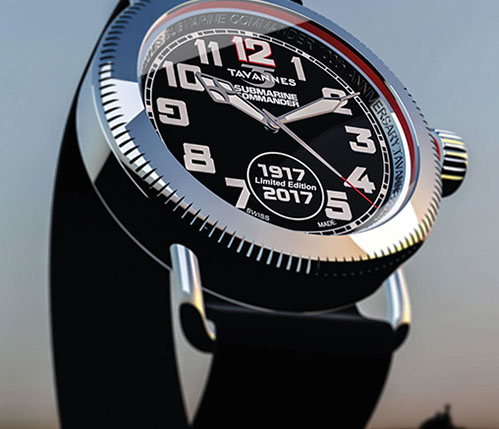
It’s been quite a banner year for the Tavannes (pronounced ta-VAHN) Watch Co. In 2017 the company rolled out four new models, all with roots in watches going as far back as 100 years. The re-issued Submarine Commander, for example, pays tribute to the watch ordered by the British Royal Navy in 1917 to withstand the harsh conditions above and below decks on subs of its fledgling fleet. The watch featured a waterproof case and crown, a full nine years before Rolex boasted the industry’s first watertight case in 1926. Other “tribute” watches include the following:
“We want to show the world just how innovative the Tavannes Watch Co. was in the early days of wristwatches,” says Bruce Cummings, who heads up the U.S. division of Tavannes Watch Co., along with son, Marc. “At one time, Tavannes was the fourth largest manufacturer of watch movements in the world, yet the brand is only just recently finding name recognition outside of Switzerland and Europe. We’re excited and hopeful that these four heritage models will bring Tavannes to the forefront.”
I caught up with Bruce and Marc, along with Tavannes’s Chief Design Officer Nicholas R. Jeanson at the JCK watch and jewelry show, held June 5–8 at the Mandalay Bay Conference Center in Las Vegas, NV. There, I got an advance peek at the four models, all of which were in prototype stage. As I am writing this article in June 2017, three of the four watches are scheduled for release in late 2017, with the Watersport coming out in 2018.
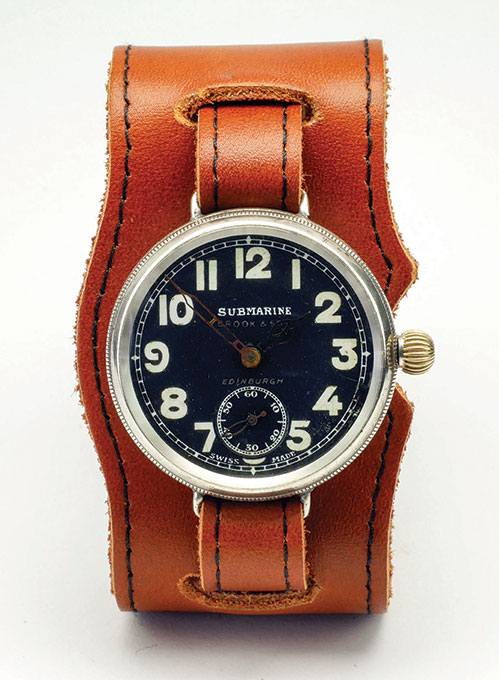
Tavannes and Its Roots
Before getting into the model specifics, a little history may be helpful. Based in the Swiss city bearing the same name, Tavannes is one of the world’s few remaining independent watch companies. It was founded in 1891 by Henri-Frédéric Sandoz. From its beginnings, Tavannes was more a “behind-the-scenes” company, making parts and ebauches (rough movements) as well as manufacturing equipment (to make watch parts), all of which were sold to other companies that made watches and/or watch parts. At its peak, Tavannes employed approximately 3,000 skilled watchmakers and produced 4,000 watch movements a day.
In 1892 the company formed a partnership with Cyma Watch Co., founded by brothers Joseph and Theodore Schwob in 1862. The two companies soon figured out that it would be most beneficial for Cyma to be the “front company,” especially in the United States where the name was more recognizable and easier to pronounce. (Tavannes still faces this issue today, although more and more retailers are learning to pronounce it correctly and are promoting the brand to their customers.) Meanwhile, Tavannes supplied the movements for most Cyma watches, but Tavannes also made complete watches that were distributed mostly in Europe, and the company had a strong presence in Asia, South America, and Canada as well. The company also produced some breakthrough movement calibers, including the 335, which had an unheard-of power reserve of three days. It also produced the Caliber 064, which powered the legendary Jaeger LeCoultre Reverso watch for the first couple years of its production until Jaeger could figure out how to make its own movement for that watch.
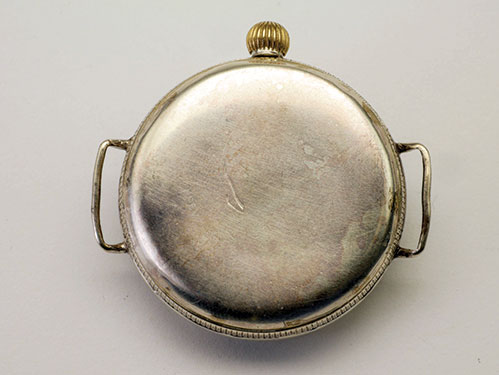
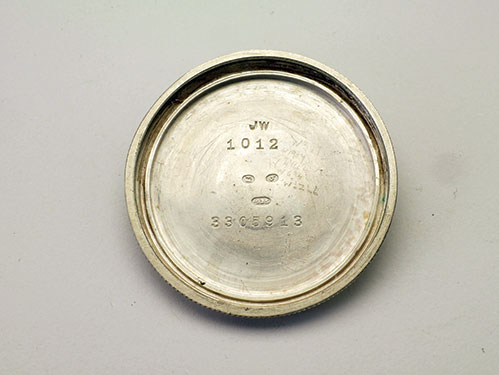
Meanwhile, the Cyma–Tavannes partnership—with each brand remaining separate entities—lasted nearly a century, until 1978. Through a series of financial twists and turns, and the Swiss watch industry in utter turmoil during this time, the two companies were sold as a package deal. The resulting single company of Cyma–Tavannes lasted until 2008 when the two brands were again split into separate companies. Cyma was sold to Stelux International, a Hong Kong-based holding company. Meanwhile, the Niculescu family, Romanian by birth, with education and citizenship in Switzerland, bought Tavannes. Currently, Tavannes Switzerland is owned by the Niculescu family, with Sandra Niculescu as head of the company and assisted by Chief Design Officer Nicolas R. Jeanson.
The “new” Tavannes of course had the misfortune of launching during one of the worst economic downturns (at least in the United States) since the Great Depression. But the company survived and even grew by offering innovative watches at very attractive prices compared with mechanical watches from other companies. An example is the TA-VON Skeleton Watch with exposed decorated manual wind movement, visible from the watch’s front and back through sapphire crystals. Tavannes priced the watch at $1,295, at a time when other companies’ mechanical watches of similar quality started at about three times that price. (The watch is currently priced at $1,375.)
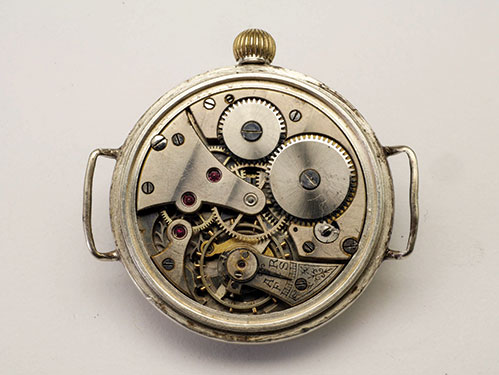
Returning to the Classics
Now with nine years under its belt, Tavannes is turning its energies to re-creating some of its classic models, modifying them somewhat to match modern consumer tastes, and bringing them up to date with better case materials and more accurate and reliable movements. Let’s begin with the Submarine Commander (SC). We know from an article that appeared in the December 1917 issue of The Horological Journal that representatives of the British Royal Navy approached Tavannes that year and requested a waterproof watch for service use. The case was made watertight with a screw-on back and bezel, both of which were fitted with compressible gaskets to improve their watertightness. A water-resistant gasket (researchers believe made of oiled leather) compressed with a specially designed threaded nut prevented moisture from entering the stem hole. The movement was the Tavannes 13 ligne Caliber 3B, fitted with a special balance for greater shock protection than some of its more standard movements. The watch measured 34.8 mm in diameter, a typical size for a watch of that era with a 13-ligne movement. Images of an original SC are shown in Figures 1–4 and are courtesy of NAWCC member David Boettcher. For a more detailed description of the original SC, see Boettcher’s article in the May/June 2014 issue of the Watch & Clock Bulletin.1
The new SC has taken form under the direction of Tavannes Switzerland, especially Chief Design Officer Jeanson, who also teaches industrial design at a Swiss university. Both divisions of Tavannes (USA and Switzerland) sought the input of collectors at large (including this author) for the design of the watch to make it as true to the original as possible. This is utterly unheard of in the Swiss watch industry. Let me repeat: utterly unheard of.
“The Niculescus’ approach is completely different from other Swiss engineers,” says Marc Cummings. “They decide on a price point that they believe is affordable compared with the competition, and figure out creative solutions to design and engineering hurdles, all the while maintaining absolute quality. Other companies start with a base cost and keep doubling the price every time they have to fix a problem.” For example, when design parameters for the SC were presented to Jeanson, he made the watch a “school project” with some of his students at the university. The students proposed designs and solved several engineering issues, while earning credit toward their degrees. Cost to Tavannes: Zero.
The new SC will be cased in all stainless steel, with a diameter of 45.5 mm, including the crown. It will have an automatic self-winding movement with a sweep seconds hand. Edges on the front and back of the bezel will be knurled, like the original, and the case will be watertight to 10 atmospheres (ATM), which is 100 meters underwater. Special “monitoring” gaskets on the bezel and crown will turn color from a bright red to a pink to indicate to the owner when the gaskets need to be replaced to retain specified water resistance. As far as I’m aware, this “monitoring gasket” concept is a first in the watch industry.
The first SCs to be released in the fall of 2017 will be a limited edition run of 100 pieces that will bear a special engraving on the back, including an image of a submarine. SCs after that initial run will have a plain back. The watch will be priced at $2,250. Images of the new SC can be seen in Figures 5–7 and are courtesy of Tavannes.
I will discuss Tavannes’s other three “heritage” watches in a future article. I wanted to write about the SC first, because I think this is an important watch for collectors to consider. Original SCs are extremely difficult to find, and the few that do appear are almost exclusively found in the United Kingdom.
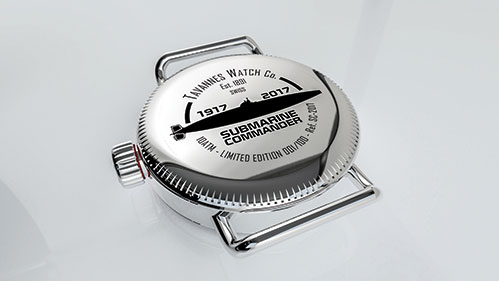
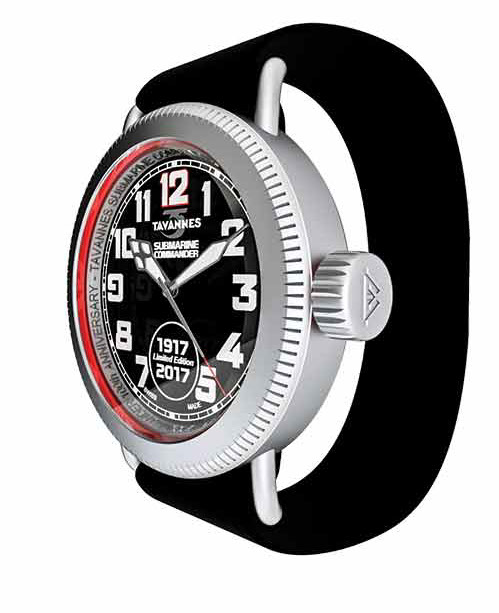
About the Author
Bruce Shawkey was the Wristwatches columnist for the Watch & Clock Bulletin from 1997 to 2016. In 2014 he was awarded the NAWCC’s prestigious James W. Gibbs Award for horological literary excellence. He has authored two books: one on Gruen wristwatches and the other on Hamilton wristwatches. Semiretired, he continues to write about wristwatches for various publications and blogs. He divides his time between Florida and his native Wisconsin.